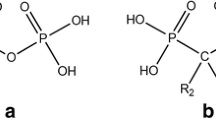Summary
Compact cylindrical implants (5 X 15.5 mm) of seven calcium phosphate ceramics of different formulations that had been implanted for 6 weeks without fixation in the tibia of dogs were examined histologically. The tissue compatibility of the implant turned out to be dependent on the mineralogical and chemical composition of the material: the ceramic material was biocompatible at a CaO/P2O5 ratio between 2: 1 and 4:1, the optimum ratio being about 3: 1 (tricalcium phosphate). In addition, cylindrical tetracalcium phosphate implants with an entirely porous structure were implanted in the same manner. After 6 months, they were resorbed to a minor extent. Implants of different calcium phosphate mixtures, on the other hand, were resorbed to a large extend after the same time. The ceramic material was replaced by mineralised bone tissue which had formed directly on the ceramic implant as well as within the pores. There were no foreign body reactions. Investigations with segment-shaped implants which were implanted in the tibia of dogs and fixed with AO-plates or splints extra-cutaneously for about 8–10 weeks, provided information about the maximum stress that can be borne by the implants. While implants with a porosity of 75 percent did not sustain the stress after the fixation had been removed, those with a porosity of 45 percent could be subjected to physiological stress after removal of the splints.
Zusammenfassung
Massive cylindrische Implantate (5 X 15,5 mm) aus sieben Calciumphosphatkeramiken verschiedener Zusammensetzung wurden ohne Fixierung in die Tibia von Hunden implantiert, nach 6 Wochen Verweilzeit entnommen und histologisch untersucht. Die Gewebeverträglichkeit erwies sich als abhängig von der mineralogischen und chemischen Zusammensetzung des Materials: Die Keramik war bei einem Ca0/ P2O5-Verhältnis von 2:1 bis 4: 1 gewebeverträglich, das Optimum lag bei etwa 3:1 (Tricalciumphosphat).
Außerdem wurden cylindrische Implantate aus Tetracalciumphosphat mit einer durchgehend porösen Struktur nach der oben beschriebenen Methode implantiert. Sie waren nach 6 Monaten wenig resorbiert. Entsprechende Implantate aus Mischungen verschiedener Calciumphosphate waren dagegen nach 6 Monaten bereits tiefgründig resorbiert. Die Keramik wurde durch mineralisiertes Knochengewebe ersetzt, das sich bevorzugt direkt auf der Keramik, auch innerhalb der Poren, bildete. Fremdkörperreaktionen traten nicht auf.
Aufschluß über die Belastbarkeit gaben Untersuchungen mit segmentförmigen Implantaten, die in die Tibia von Hunden eingesetzt und mit AO-Platten bzw. mit Schienen extracutan für etwa 8–10 Wochen fixiert wurden. Während Implantate mit 75 % Porosität nach Aufhebung der Fixierung der Belastung nicht standhielten, konnten solche mit 45 % Porosität physiologisch belastet werden.
Similar content being viewed by others
Literatur
Becker, E.: Über die Osteosynthese bei kleinen Haustieren und kleinen landwirtschaftlichen Nutztieren mit Hilfe eines hierfür zusammengestellten Instrumentariums. Dtsch. tierärztl. Wschr.66, 345 (1959)
Bhaskar, S. N., Brady, J. M., Getter, L., Grower, M. F., Driskell, T.: Biodegradable ceramic implants in bone. J. Oral Surg.32, 336–346 (1971)
Chakour, K.: Klinische Untersuchungen über die Leistungsfähigkeit des Kieler Knochenspanes. Z. Orthop.112, 207–217 (1974)
Getter, L., Bhaskar, S. N., Cutright, D. E., Perez, B., Brady, J. M., Driskell, T. D., O'Hara, M. J.: Three biodegradable calcium phosphate slurry implants in bone. J. Oral Surg.30, 263–268 (1972)
Karbe, E., Köster, K., Kramer, H., Heide, H., Kling, G., König, R.: Knochenwachstum in porösen, keramischen Implantaten beim Hund. Langenbecks Arch. Chir.338, 109–116 (1975)
Schweiberer, L.: Experimentelle Untersuchungen von Knochentransplantaten mit unveränderter und mit denaturierter Knochengrundsubstanz. Hefte zur Unfallheilkunde — Beihefte zur Monatsschrift für Unfallheilkunde, Versicherungs-, Versorgungs- u. Verkehrsmedizin103, 32–68 (1970)
Tscherne, H., Schmit-Neuerburg, K. P., Greif, E.: Die Einheilung verschiedener Knochentransplantate bei stabiler Osteosynthese. Verh. dtsch. Ges. Path., 58. Tagung (Hrsg. G. Seifert), S.418–422. Stuttgart: Fischer 1974
Author information
Authors and Affiliations
Additional information
deDie Untersuchungen sind Teil einer Forschungsarbeit, die das Battelle-Institut, Frankfurt am Main, im Auftrag des Bundesministeriums für Forschung und Technologie durchführt
Rights and permissions
About this article
Cite this article
Köster, K., Karbe, E., Kramer, H. et al. Experimenteller Knochenersatz durch resorbierbare Calciumphosphat-Keramik. Langenbecks Arch Chiv 341, 77–86 (1976). https://doi.org/10.1007/BF01262779
Received:
Issue Date:
DOI: https://doi.org/10.1007/BF01262779




